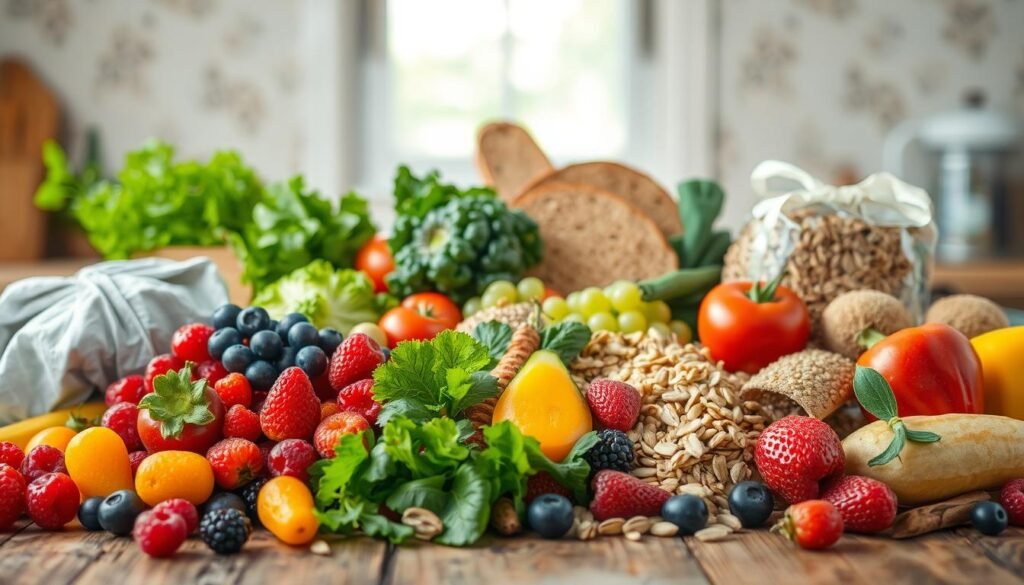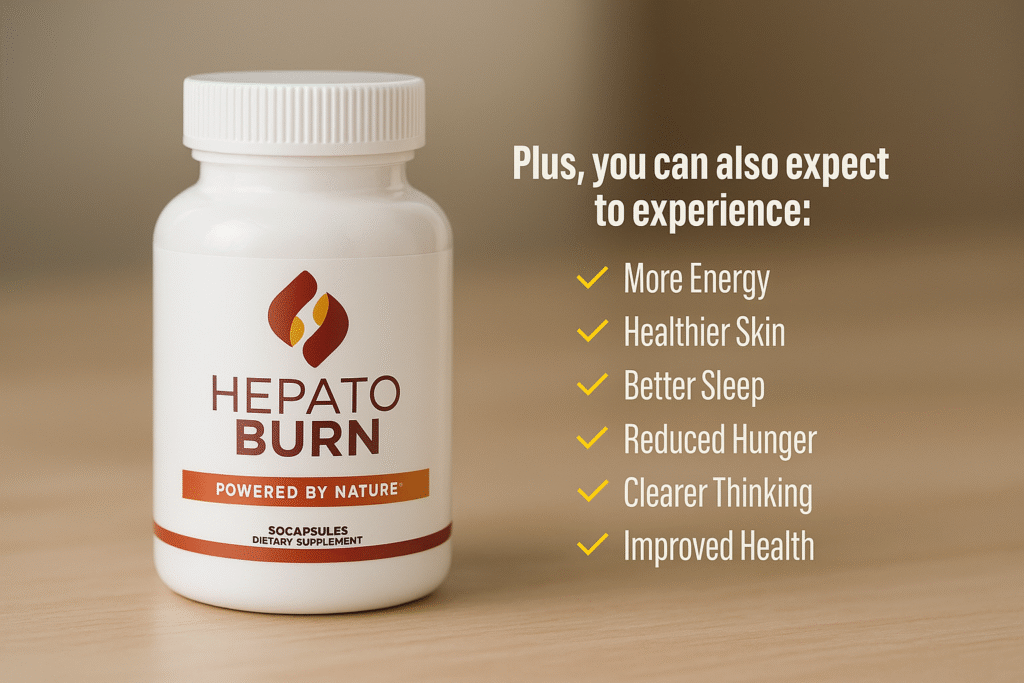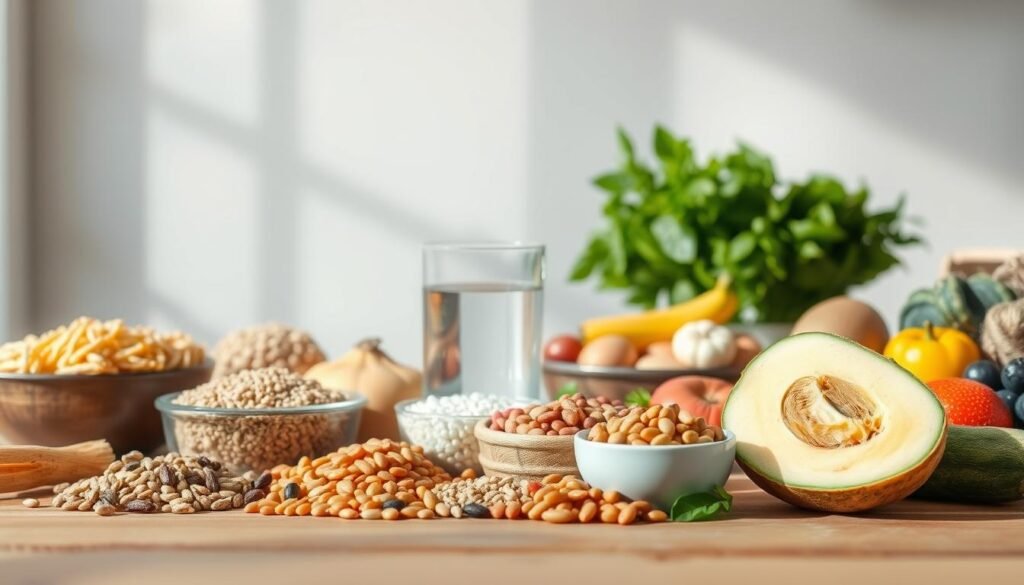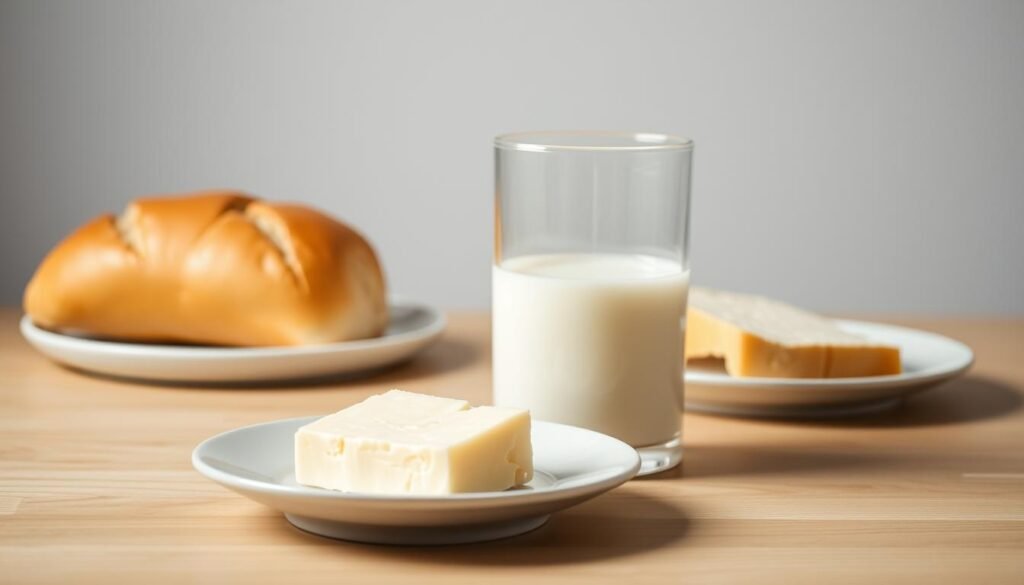
We understand how frustrating slow digestion can be. It drains energy, disrupts routines, and often leaves you wondering what actually works. That’s why we created this guide—to give you clear, real-life solutions built around a high fiber diet for constipation. By increasing bulk and water content in your stool, fiber helps ease bowel movements and supports long-term gut health.
In this guide, we’ll outline daily fiber targets, gentle ways to increase intake, and quick wins—like prunes or a hot cup of coffee—to jump-start digestion. We’ll also highlight foods that can slow things down and emphasize the role of hydration and physical activity. Later, we’ll explore “natural” digestive aids using the same practical lens.
Key Takeaways
- Adding bulk and fluids helps create softer, easier-to-pass stools.
- Gradual increases prevent excess gas and improve long-term comfort.
- Targets and simple swaps make consistent change realistic.
- Short-term options can provide relief while you build new habits.
- Work with a clinician if constipation is chronic or severe.
Why fiber matters for constipation relief right now
Knowing what fiber does in the intestines gives us practical steps to relieve common stool problems today.
We describe two types fiber and why both matter. Soluble fiber dissolves in water and forms a gel that softens stool. Insoluble fiber adds bulk and helps speed transit through the gut.
That combination supports the microbiome and improves gut motility. The result is fewer symptoms like straining, hard stools, and infrequency when we stay consistent.
Most adults in the U.S. do not get enough fiber, so we recommend gradual increases. Aim toward 25–30 g/day for women and 30–38 g/day for men to avoid added gas and bloating.
- Pair plant foods with more water so the gel-forming action works.
- Keep regular meal times—eating often triggers natural bowel movements.
- Focus on food-first strategies before trying supplements; we’ll evaluate products like HepatoBurn later in the guide.

Fruits that help get things moving
Certain fruits combine bulk and gentle osmotic effects to move things along with minimal upset.
Prunes and prune juice: fiber plus sorbitol
Prunes pack about 3 g fiber per 1/4 cup and contain sorbitol, which can soften stools and prompt a bowel response. Start with a small serving when you need quick relief.
Apples and pears with the skin
Leave the skin on to keep insoluble fiber that adds bulk. The flesh supplies soluble fiber (pectin) and gentle sugars that aid regularity.
Kiwis, figs, and citrus
Kiwis (about 2.3 g each) may boost gut motility via actinidin. Dried figs are fiber-dense and useful as a snack. Citrus fruits add 3.7–5 g per serving; peels are rich in pectin and compounds linked to laxative effects.
“Simple fruit swaps at breakfast or as snacks can sustain softer, more frequent bowel habits.”
| Fruit | Serving | Fiber (g) | Key benefit |
|---|---|---|---|
| Prunes | 1/4 cup | 3.0 | Sorbitol + bulk to relieve constipation |
| Apple (with skin) | 1 medium | 4.8 | Pectin and insoluble skin for stool consistency |
| Kiwi | 1–2 fruits | 2.3 ea | May support motility |
| Dried figs | 1/2 cup | 7.3 | High bulk for frequency |
- Add chopped prunes to oatmeal or blend kiwi into a smoothie.
- Start with modest portions and adjust based on tolerance.
- Pair these foods with water and regular meals to best relieve constipation.
Vegetables to add bulk and soften stool
Choose vegetables that help stool hold water and pass more easily. We build plates around leafy greens, crucifers, and select root vegetables to improve texture and comfort.
Leafy greens and crucifers
Spinach, Brussels sprouts, and broccoli add reliable amounts of vegetables and measured fiber to meals. Cooked spinach gives about 1.6 g per 100 g, five Brussels sprouts offer roughly 3.5 g, and a cup of broccoli supplies about 2.4 g.
Artichoke, chicory, and Jerusalem artichoke
Artichokes pack near 6.9 g each and act as prebiotic foods. Chicory and Jerusalem artichoke provide inulin; studies that used about 12 g/day of inulin showed better stool frequency and softness.
Rhubarb and sweet potatoes
Rhubarb contains sennosides that can draw water into stool when used occasionally. A medium sweet potato (skin on) offers ~3.6 g and combines insoluble fiber with pectin to add bulk and softness.
- Aim for a cup of broccoli, a medium artichoke, or a sweet potato across the day to move toward targets.
- Start small with crucifers to limit gas and increase servings gradually.
- Drink water with meals so plant compounds can hold fluid inside stool and ease bowel passage.
Legumes and seeds for reliable bowel movements
Legumes and small seeds are practical tools we can use to make stools softer and more regular. They combine soluble and insoluble components that add bulk and retain water in the gut.
Beans, peas, and lentils: soluble and insoluble working together
Beans are dense sources: navy beans deliver about 19.1 g per cup, and lentils give ~7.8 g per 1/2 cup. These foods supply mixed fiber that bulks stool and speeds transit.
Start with 1/2 cup lentils in soups or add a cup of beans to salads or tacos. Rinse canned beans and cook dried legumes until tender to reduce gas.
Chia seeds: water-absorbing gel that eases passage
Chia offers ~9.8 g per ounce and soaks up up to 12x its weight in water, forming a gentle gel that softens stool. Stir 1 tablespoon into yogurt or overnight oats with extra liquid and drink water with it.
Flaxseeds: mixed fibers and safe use
Whole flax gives ~2.5 g per tablespoon. Use ground or whole in smoothies, hot cereal, or baked snacks. A 12-week study linked flaxseed snacks to reduced constipation and metabolic benefits; consult a clinician if pregnant or lactating.
- Tip: Increase legumes slowly to limit gas, and track stool frequency and consistency as you adjust portions.
- Prep: Pressure-cook dried beans, season with spices, and pair seeds with extra water so the gel action works safely in the bowel.
Whole grains and fermented dairy that support gut health
We can pair simple grain swaps with cultured dairy to ease stool passage and support overall gut comfort.
Rye and oat bran to form larger, softer stools
Rye bread is a practical swap. Two slices (64 g) give about 3.7 g of fiber and help form larger, softer stool that passes more easily.
Oat bran packs roughly 4.8 g per 1/3 cup raw. Use it in pancakes or stirred into yogurt to boost breakfast bulk without extra volume.
Kefir: probiotics that may ease discomfort
Kefir is a cultured dairy drink rich in live microbes. Studies that used about 400 mL twice daily showed improved microbiome markers and less abdominal pain in some groups. Small daily servings can diversify microbes and may reduce discomfort while we shift grain choices.
- Swap refined rolls with whole-grain rye at lunch or dinner.
- Add 2–4 tablespoons oat bran to morning recipes to increase stool softness.
- Try kefir in smoothies with fruit and oat bran to combine bulk and probiotics.
| Food | Typical Portion | Notable Benefit |
|---|---|---|
| Rye bread | 2 slices (64 g) | ~3.7 g fiber; larger, softer stool |
| Oat bran | 1/3 cup raw | ~4.8 g fiber; boosts morning bulk |
| Kefir | Small daily serving | Probiotics that may ease abdominal pain and support the gut |
Practical tips: Read labels and pick whole grains as the first ingredient. Increase fluids as grain portions rise so stool stays soft and bowel movements remain regular.
How to build a high fiber diet for constipation without the bloat

We know gradual change matters when aiming to ease stool passage without adding gas or cramping.
Portion targets: working up toward daily goals
Set realistic targets: women ~25–30 g/day; men ~30–38 g/day. We recommend adding about 5 grams every few days until you reach your goal.
Use simple swaps: add a serving of fruit, an extra 1/4 cup beans, or a tablespoon of chia to hit small steps. Track stool changes and adjust pace if gas or bloating appears.
Increase gradually and pair increases with water
Fluid is essential. Soluble fibers need 8–10 cups daily so they form a softening gel. When we up portions, we also add sips of water throughout the day.
Gentle movement helps too—try a 10–20 minute walk after meals to support regular movement and reduce bloating.
HepatoBurn Review: what we look for before considering any “natural” digestive aid
We evaluate supplements by strict criteria:
- Published human studies showing relief of relevant symptoms.
- Transparent labels with clinically relevant doses.
- Clear safety data and interaction warnings.
- Third-party testing and regulatory status.
- Honest claims that avoid overpromising.
Caution: Some herbal blends contain stimulant laxatives that may cause diarrhea or worse. We prioritize food-first approaches and well-studied options like psyllium when needed. Always discuss supplements with your doctor, especially with chronic constipation or ongoing meds.

Hydration, hot beverages, and movement to boost motility
Routine water intake and short walks turn food choices into reliable bowel relief.
Drink more water so fiber can do its job
Aim for 8–10 cups (2–2.5 L) of fluids daily. This keeps stool soft and prevents hard, dry stools that slow transit. We suggest sipping across the day and refilling a visible bottle at set times.
Hot coffee or tea and a post-meal walk for timely bowel movements
Warm beverages can prompt the intestines. Caffeine and temperature often speed a morning response.
After meals, a 10–20 minute walk uses natural abdominal signals and supports regular movements. Even brief activity reduces cramping and pain.
“Consistency—same times each day—helps train predictable toilet responses and improves regularity.”
| Tip | Why it helps | Best times |
|---|---|---|
| 8–10 cups daily | Allows bulk to hold moisture; softer stools | All day; extra morning glass |
| Warm coffee or tea | Stimulates intestinal contractions | Within 30–60 minutes of waking |
| Short post-meal walk | Boosts digestive movements and timing | 10–20 min after breakfast or dinner |
Practical pairings: drink a glass with each snack or meal and do gentle core stretches to improve posture before sitting down. Small, steady changes make the rest of our plan more effective.
What to limit when constipated

When stools slow, what we avoid can matter as much as what we add.
Certain foods—especially ultra-processed and very fatty choices—tend to slow gut transit and displace more helpful options. Fried items, processed meats, and many baked goods are low in bulk and can make bowel movements firmer. Cheese and other unfermented dairy often worsen symptoms in people who notice they feel sluggish after eating them.
Alcohol and foods high in saturated or trans fats may increase bloating and delay passage. Highly refined grains and pastries offer little to no bulk compared with whole-grain swaps, so they can contribute to chronic problems over time.
Practical swaps and cautions
- Replace white bread and cookies with whole-grain or seeded crackers to keep stool softer.
- Choose fermented dairy like kefir or yogurt if unfermented cheese causes issues.
- Limit greasy snacks and choose nuts, fruit, or a small serving of beans instead of chips or sweets.
- If you follow a keto-style eating plan, work with a clinician to add low-carb sources of bulk so the meal pattern does not cause constipation.
“Occasional, directed use of laxatives can help, but long-term reliance may worsen bowel function.”
| When to see a doctor | What to watch for |
|---|---|
| No bowel movement for 3 days | May need medical review, especially with pain |
| Severe abdominal pain, vomiting, or blood in stool | Seek immediate care |
| Ongoing or worsening symptoms | Evaluate chronic constipation and adjust treatment with a clinician |
Simple rule: the more minimally processed the food, the better it tends to be for regularity and overall gut health. We recommend tracking which items cause gas or slowing and adjusting the meal plan accordingly.
Conclusion
, Our main message: steady changes to meals, water, and movement give the gut the best chance to work reliably.
We recommend aiming toward 25–30 g/day for women and 30–38 g/day for men, increasing slowly over days to limit gas and bloating. Drink 8–10 cups of fluids, enjoy a warm morning beverage, and take short walks after meals to prompt natural bowel movements.
Choose the fruits, vegetables, legumes, seeds, whole grains, and fermented dairy that form softer, bulkier stool. Keep skin on produce when possible. Limit ultra-processed, fatty foods and unfermented cheese.
Note: track patterns, avoid daily reliance on stimulant laxatives, and consult a clinician about chronic constipation or severe pain. Use supplements only when evidence, labeling, and safety are clear.
FAQ
What types of fruits help ease constipation and how should we eat them?
Fresh prunes, apples, pears, kiwi, figs, and citrus are strong choices. Prunes and prune juice offer sorbitol plus bulk. Apples and pears eaten with the skin add pectin and insoluble matter. Kiwis and figs deliver dense plant matter that stimulates motility. We recommend whole fruit over juice when possible and spacing servings across the day to avoid gas.
Which vegetables best soften stool and add bulk?
Leafy greens like spinach and cruciferous vegetables such as Brussels sprouts and broccoli provide both soluble and insoluble components that increase stool volume. Artichokes, chicory, and Jerusalem artichoke contain inulin, a prebiotic that feeds gut bacteria. Sweet potatoes with the skin supply a mix of fibers that help retain water in the bowel.
Are beans, lentils, and seeds safe to use to relieve constipation?
Yes. Beans, peas, and lentils combine soluble and insoluble material to normalize bowel rhythm. Chia forms a gel when mixed with liquid, easing passage; flaxseeds add bulk but should be ground for best effect. Introduce these gradually to lower the risk of gas and bloating.
How do whole grains and fermented dairy support regular movements?
Whole grains like rye and oat bran increase stool size and softness, improving transit. Fermented dairy such as kefir supplies probiotics that can improve microbiome balance and reduce discomfort. Choose minimally processed options and monitor tolerance, especially with lactose sensitivity.
How quickly should we increase intake to avoid bloating and gas?
Raise portions slowly over one to three weeks rather than abruptly. Small, steady increases give gut bacteria time to adapt. Pair added plant matter with extra fluids and, if needed, adjust meal timing to minimize discomfort.
How much fluid should we drink when adding more plant-based foods?
We advise sipping water throughout the day so soluble material can swell and move stool forward. Aim for at least eight cups daily, more if you are active or live in a warm climate. Warm drinks before breakfast often help prompt a morning bowel movement.
Can coffee or tea help prompt a bowel movement?
Yes. Hot coffee and some teas stimulate colonic activity for many people, particularly after meals. Combining a warm beverage with a brief walk can encourage timely evacuation without medications.
Which foods should we limit because they slow motility?
High-fat and heavily processed items, large servings of unfermented dairy, and low-residue snacks can delay transit. Alcohol and very low-water foods like crackers or processed cookies may worsen symptoms; favor whole, hydrated choices instead.
When should we consider supplements or laxatives and consult a clinician?
Try gradual dietary changes, hydration, movement, and probiotic-rich foods first. If symptoms persist for more than two weeks, if stool becomes bloody, or if pain or vomiting occur, we should see a clinician. A provider can recommend bulking agents, osmotic laxatives, or targeted tests when needed.
Are there precautions with seeds or products that expand when wet?
Yes. Chia and psyllium absorb liquids and swell; always mix them with enough fluid and avoid dry swallowing. People with swallowing difficulties or strictures should use these only under medical advice to prevent obstruction.
What role do prebiotics and probiotics play in relieving chronic constipation?
Prebiotic compounds like inulin feed beneficial bacteria, which can improve stool consistency and frequency over weeks. Probiotic foods and supplements, including kefir, may reduce bloating and pain while supporting motility. Results vary, so we watch effects for several weeks and adjust accordingly.
Can certain sweeteners or sugar alcohols cause problems?
Sorbitol and other sugar alcohols in some fruits and low-calorie foods can relieve constipation at moderate levels but cause gas or diarrhea in sensitive individuals. We recommend monitoring tolerance and choosing whole-food sources first.
How do we balance increasing intake without exceeding calorie goals or causing weight changes?
Focus on nutrient-dense, lower-calorie choices such as vegetables, legumes, and fruit portions rather than adding calorie-heavy snacks. Replace processed items with whole grains and plant proteins to improve bowel function while maintaining energy balance.
Is there any reason to avoid certain products labeled as “natural digestive aids”?
We evaluate ingredients and evidence before trying supplements. Some contain stimulant compounds or unproven blends that may interact with medications or cause cramping. Discuss new products with a clinician, especially if you take other medicines or have chronic conditions.